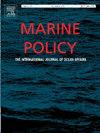受到土著居民和当地社区挑战的一般海洋保护区模式:如何调整或重新发明该模式?
IF 3.7
2区 社会学
Q2 ENVIRONMENTAL STUDIES
引用次数: 0
摘要
许多海洋保护区(MPAs)面临社会接受的困难。这项对横跨五大洲的13个海洋保护区的比较分析旨在通过比较它们的本地化过程来解释这些问题,以确定可能的重复机制。通过分析海洋保护区的发展轨迹及其引发的冲突,可以发现存在一种普遍适用的隐性海洋保护区模式。它使我们能够确定这个模型的7个组成部分:谁决定,什么使决定合法化,决定的时代性和向量,然后,在行动模式中,与区域的关系,与自然的关系,与交流的关系以及行动的呈现和组织。揭示这个模型使得解释产生的误解和许多导致冲突和低效率的验收问题成为可能。根据对MPA模式的局部适应或重新发明的观察,提出了对该模式进行全球彻底检查的建议。让它更灵活,更开放,以多种方式思考自然和保护。本文章由计算机程序翻译,如有差异,请以英文原文为准。
A generic marine protected area model, challenged by indigenous peoples and local communities: How can the model be adapted or reinvented?
Many Marine Protected Areas (MPAs) face difficulties of social acceptance. This comparative analysis of 13 MPAs spanning five continents aims to explain these problems by comparing their localization processes in order to identify possible recurring mechanisms. Analyzing their trajectories and the conflicts they cause reveal the existence of a generic model of Marine Protected AreaS which is mostly implicit and applied everywhere. It enables us to identify 7 components of this model: who decides, what legitimizes the decision, the decision’s temporalities and vectors, and then, inside the action modalities, the relationship with the area, with nature, with exchange and the action presentation and organization. Laying bare this model makes it possible to explain the misunderstandings that arise and many acceptance problems that lead to conflict and inefficiency. Based on observations of local adaptations or reinventions of the MPA model, proposals are made for a global overhaul of the model. to make it more flexible and open to multiple ways of thinking about nature and conservation.
求助全文
通过发布文献求助,成功后即可免费获取论文全文。
去求助
来源期刊

Marine Policy
Multiple-
CiteScore
7.60
自引率
13.20%
发文量
428
期刊介绍:
Marine Policy is the leading journal of ocean policy studies. It offers researchers, analysts and policy makers a unique combination of analyses in the principal social science disciplines relevant to the formulation of marine policy. Major articles are contributed by specialists in marine affairs, including marine economists and marine resource managers, political scientists, marine scientists, international lawyers, geographers and anthropologists. Drawing on their expertise and research, the journal covers: international, regional and national marine policies; institutional arrangements for the management and regulation of marine activities, including fisheries and shipping; conflict resolution; marine pollution and environment; conservation and use of marine resources. Regular features of Marine Policy include research reports, conference reports and reports on current developments to keep readers up-to-date with the latest developments and research in ocean affairs.
 求助内容:
求助内容: 应助结果提醒方式:
应助结果提醒方式:


